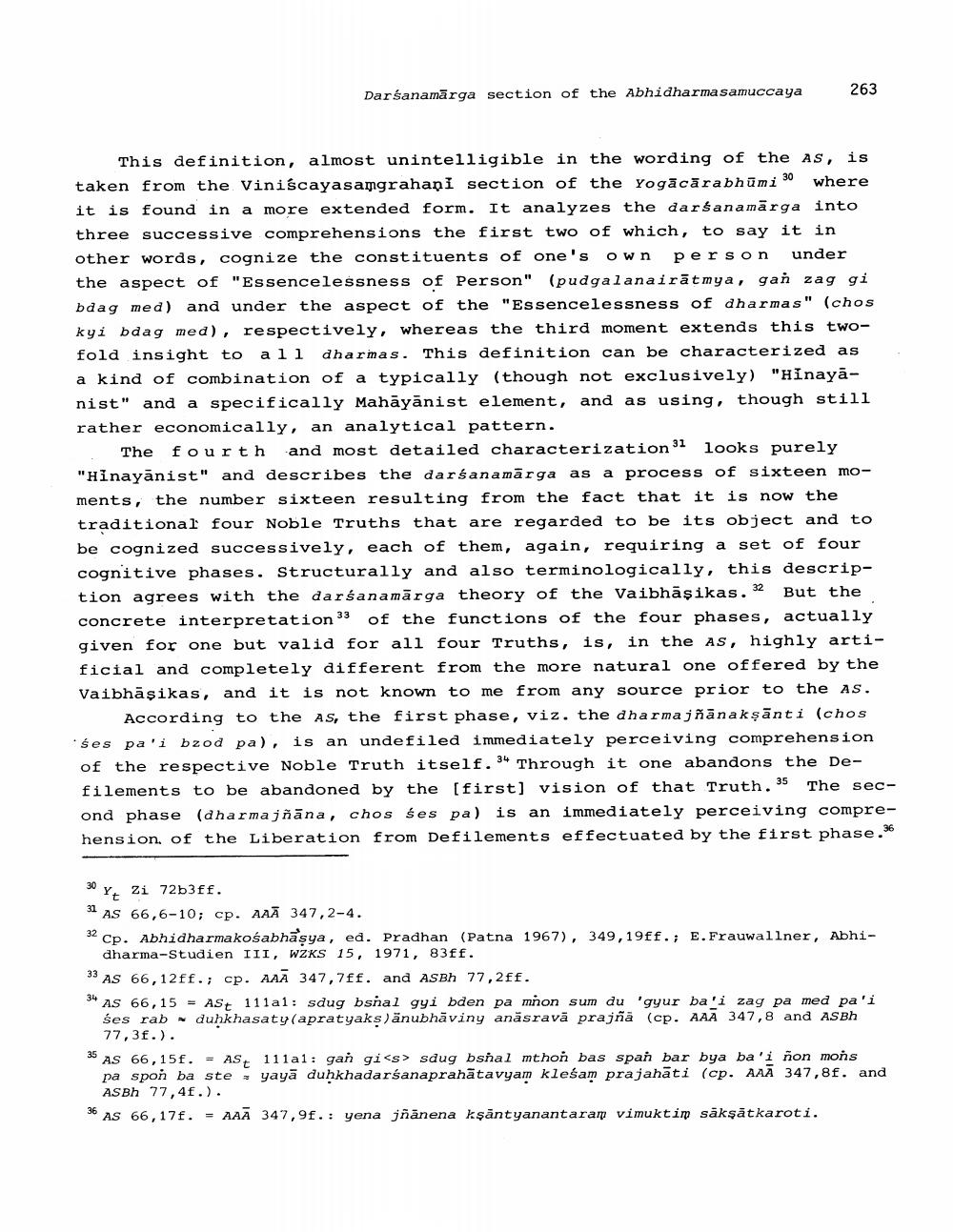________________
Darsanamārga section of the Abhidharma samuccaya
263
This definition, almost unintelligible in the wording of the As, is taken from the Viniscayasamgrahani section of the Yogācārabhūmi 30 where it is found in a more extended form. It analyzes the darśanamārga into three successive comprehensions the first two of which, to say it in other words, cognize the constituents of one's own person under the aspect of "Essencelessness of Person" (pudgalanairātmya, gan zag gi bdag med) and under the aspect of the "Essencelessness of dharmas" (chos kyi bdag med), respectively, whereas the third moment extends this twofold insight to all dharinas. This definition can be characterized as a kind of combination of a typically (though not exclusively) "Hinayanist" and a specifically Mahāyānist element, and as using, though still rather economically, an analytical pattern.
The fourth and most detailed characterization 91 looks purely "Hinayānist" and describes the darśanamārga as a process of sixteen moments, the number sixteen resulting from the fact that it is now the traditional four Noble Truths that are regarded to be its object and to be cognized successively, each of them, again, requiring a set of four cognitive phases. Structurally and also terminologically, this description agrees with the darśanamārga theory of the Vaibhāşikas. » But the concrete interpretation 33 of the functions of the four phases, actually given for one but valid for all four Truths, is, in the As, highly artificial and completely different from the more natural one offered by the Vaibhāşikas, and it is not known to me from any source prior to the As.
According to the AS, the first phase, viz. the dharmajñānakşānti (chos *ses pa'i bzod pa), is an undefiled immediately perceiving comprehension of the respective Noble Truth itself. 34 Through it one abandons the Defilements to be abandoned by the [first] vision of that Truth. 35 The second phase (dharmajñāna, chos ses pa) is an immediately perceiving comprehension of the Liberation from Defilements effectuated by the first phase.*
30 Y Zi 72b3ff. 31 AS 66,6-10; cp. AAĀ 347,2-4. 32 CP. Abhidharmakośabhasya, ed. Pradhan (Patna 1967), 349,19ff.; E.Frauwallner, Abhi
dharma-Studien III, WZKS 15, 1971, 83ff. » AS 66,12ff.; cp. AAĀ 347,7ff. and ASBH 77,2ff. 34 AS 66,15 = ASt 111a1: sdug bsnal gyi bden pa mnon sum du 'gyur ba'i zag pa med pa'i
ses rab - dunkhasaty (apratyaks)änubhāviny anāsravä prajña (cp. AAA 347,8 and ASB 77,3f.). 35 AS 66,15f. = AS 111a1: gan gi<s> sdug bsnal mthon bas span bar bya ba'i non mons
pa spon ba ste , yayā duhkhadarśanaprahātavyam kleśam prajahāti (cp. AAA 347,8f. and
ASBh 77,4.). 36 AS 66,17f. = AAĀ 347,9f.: yena jñanena kşāntyanantaram vimukt im säkşātkaroti.




